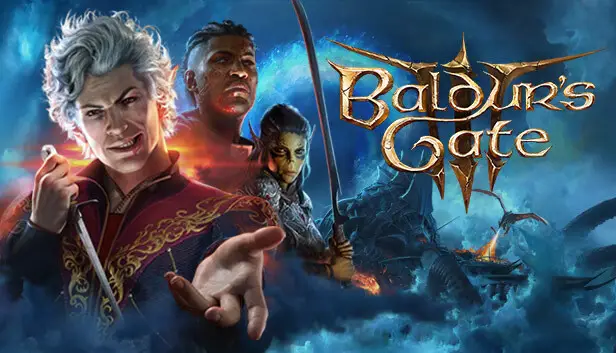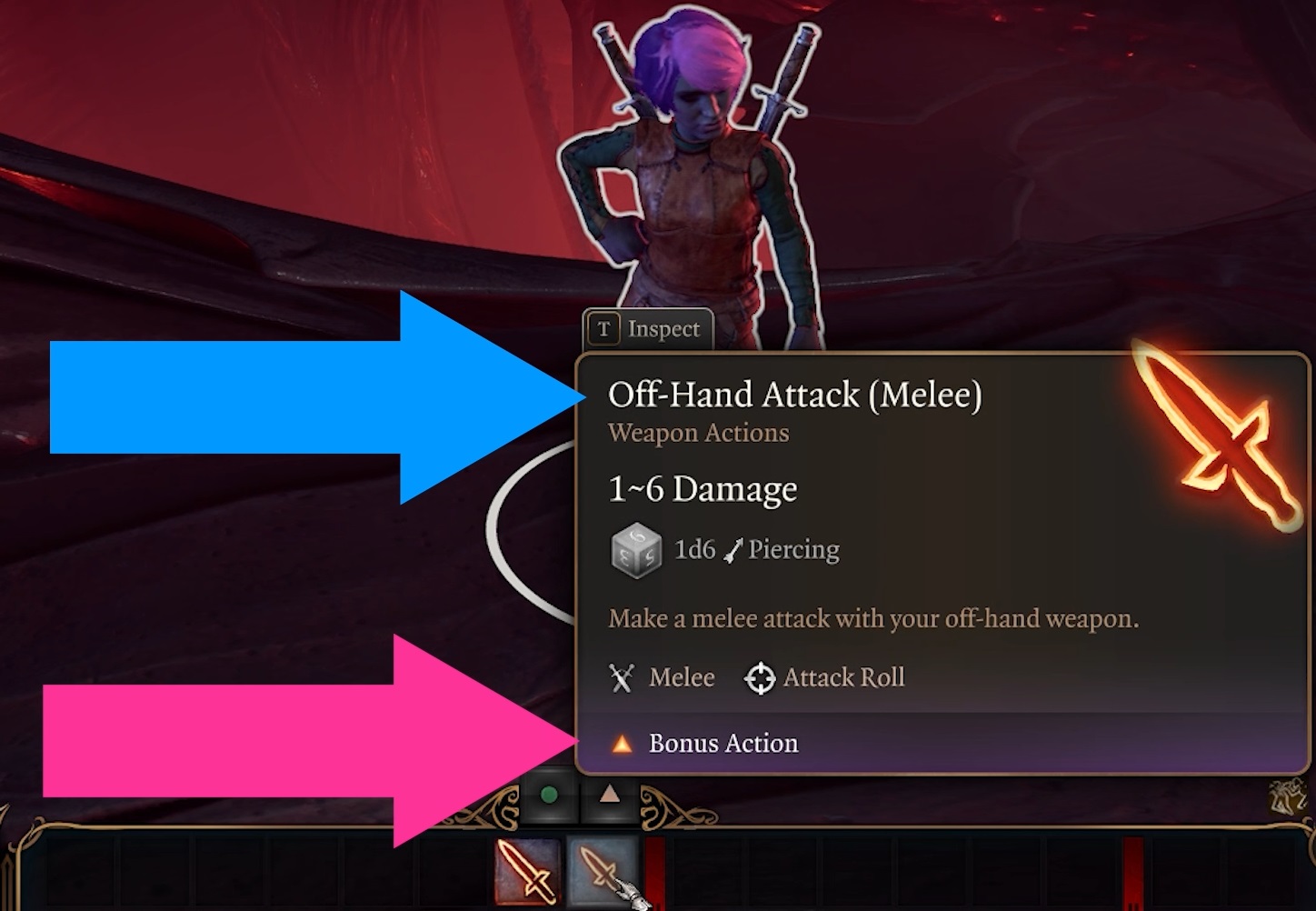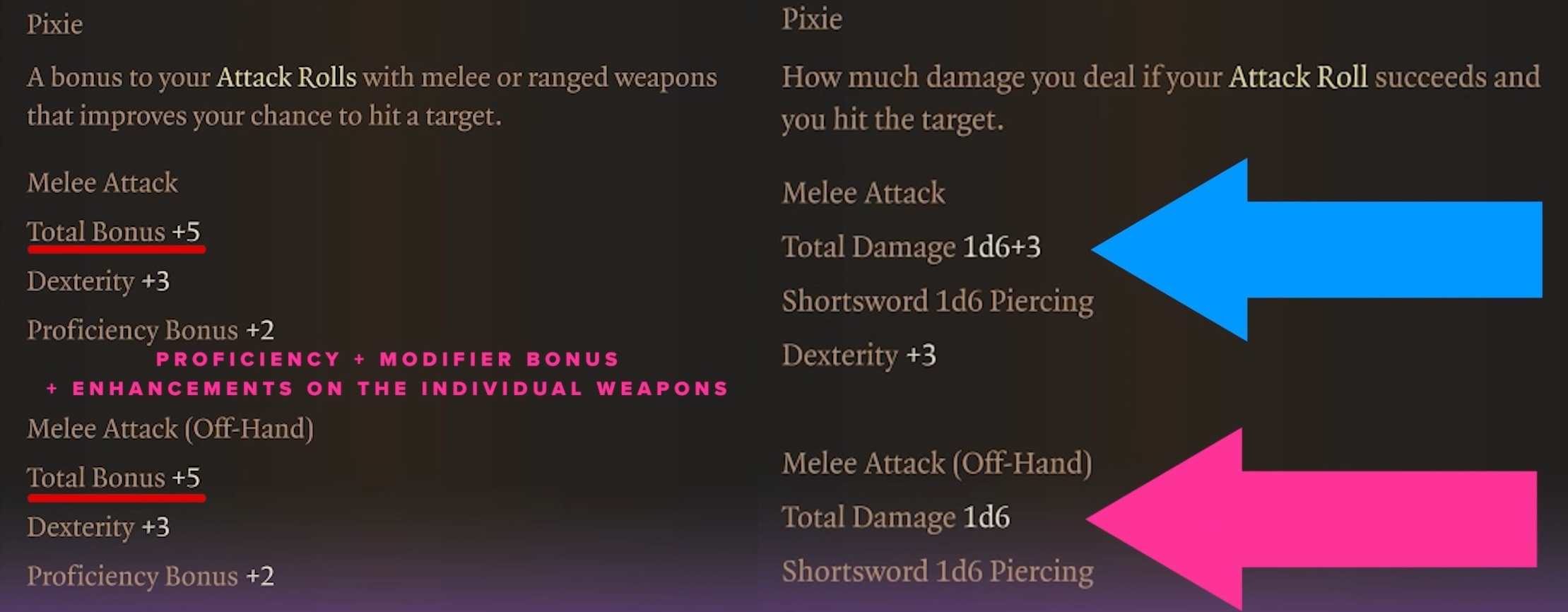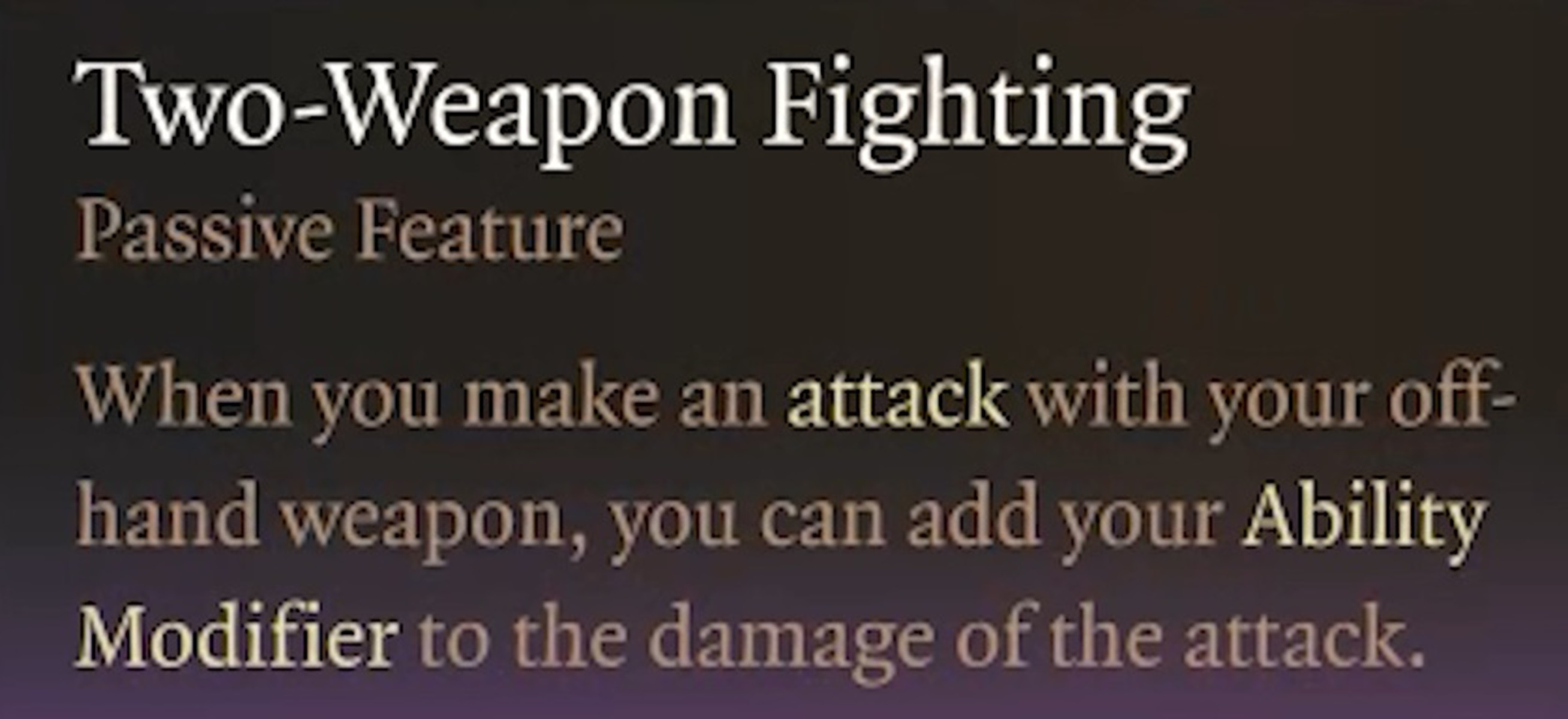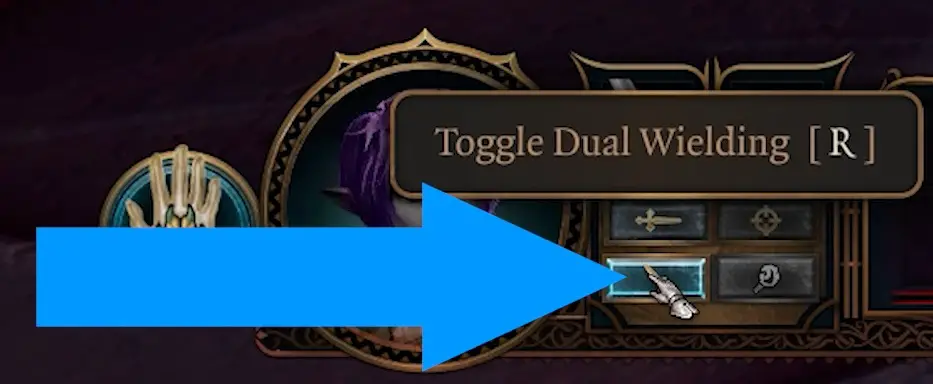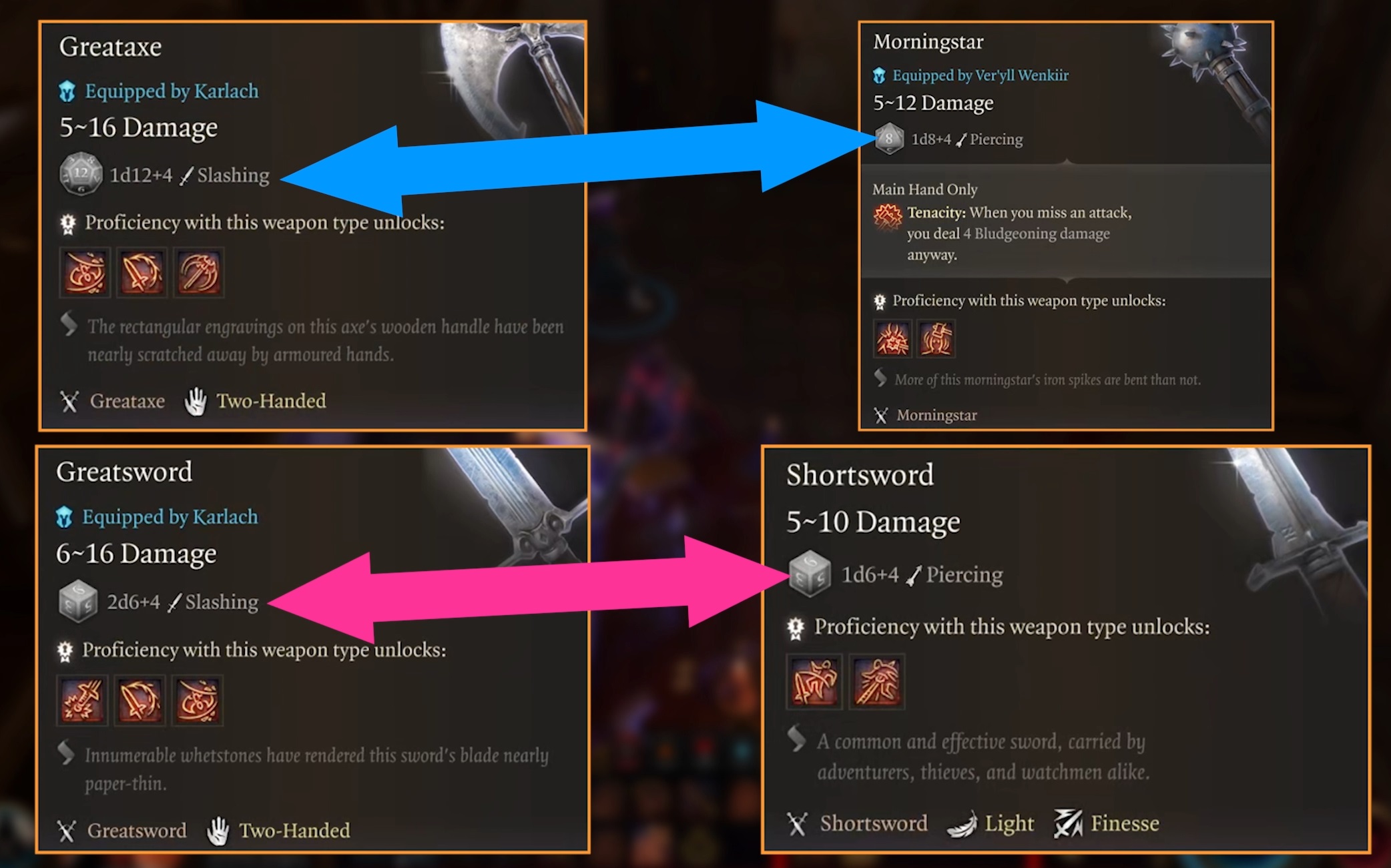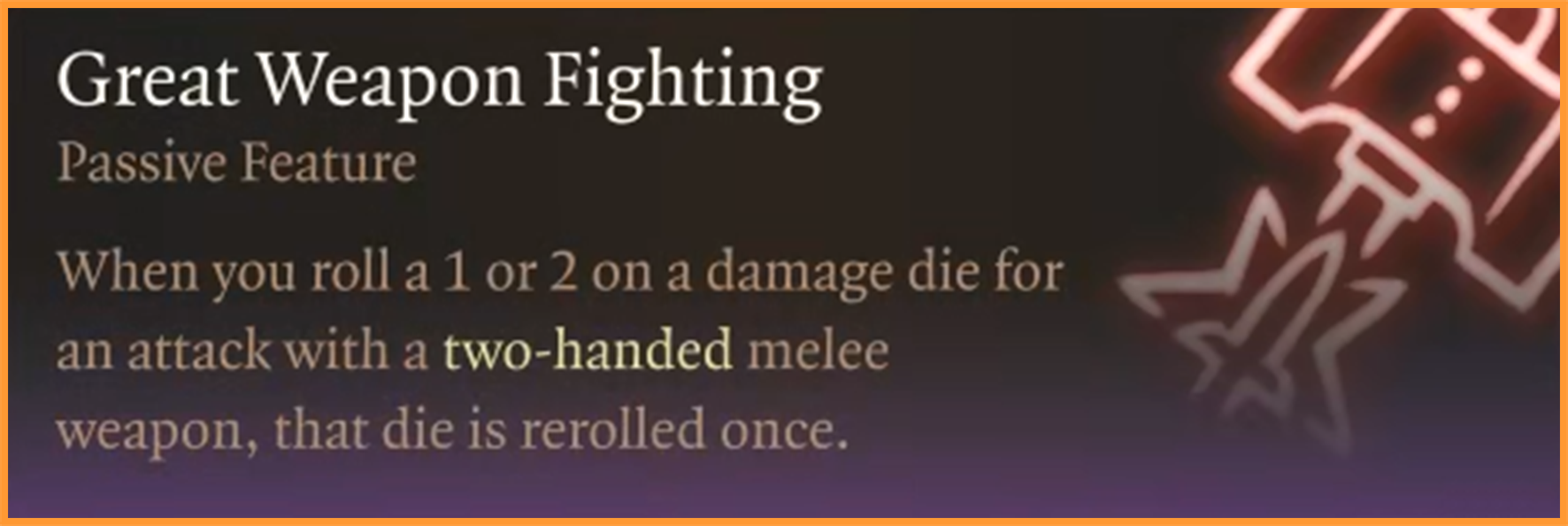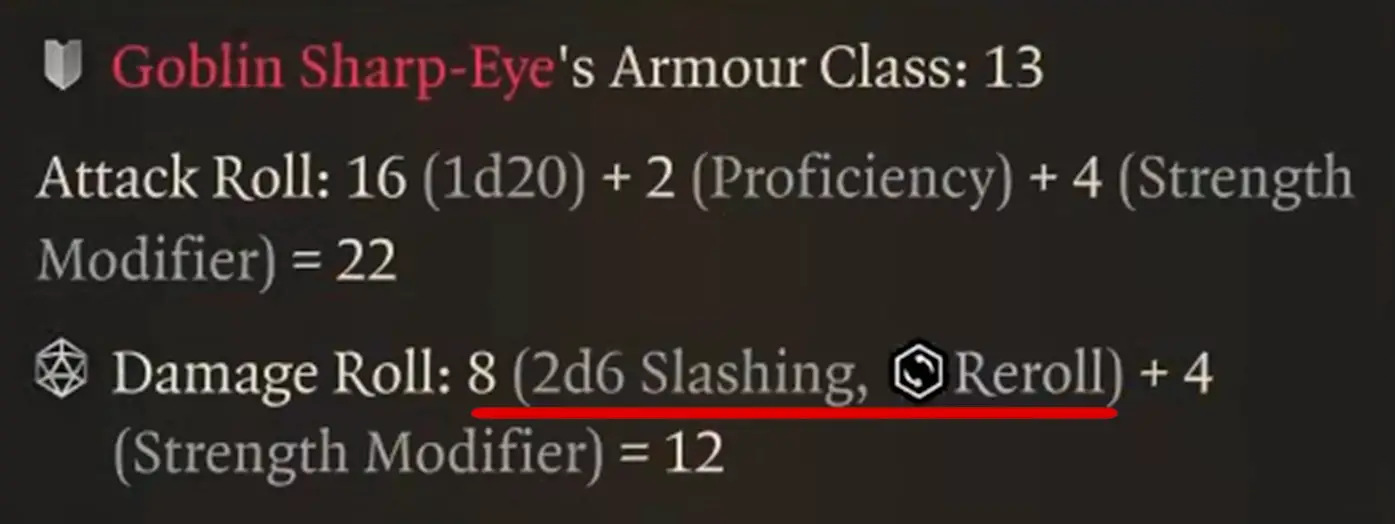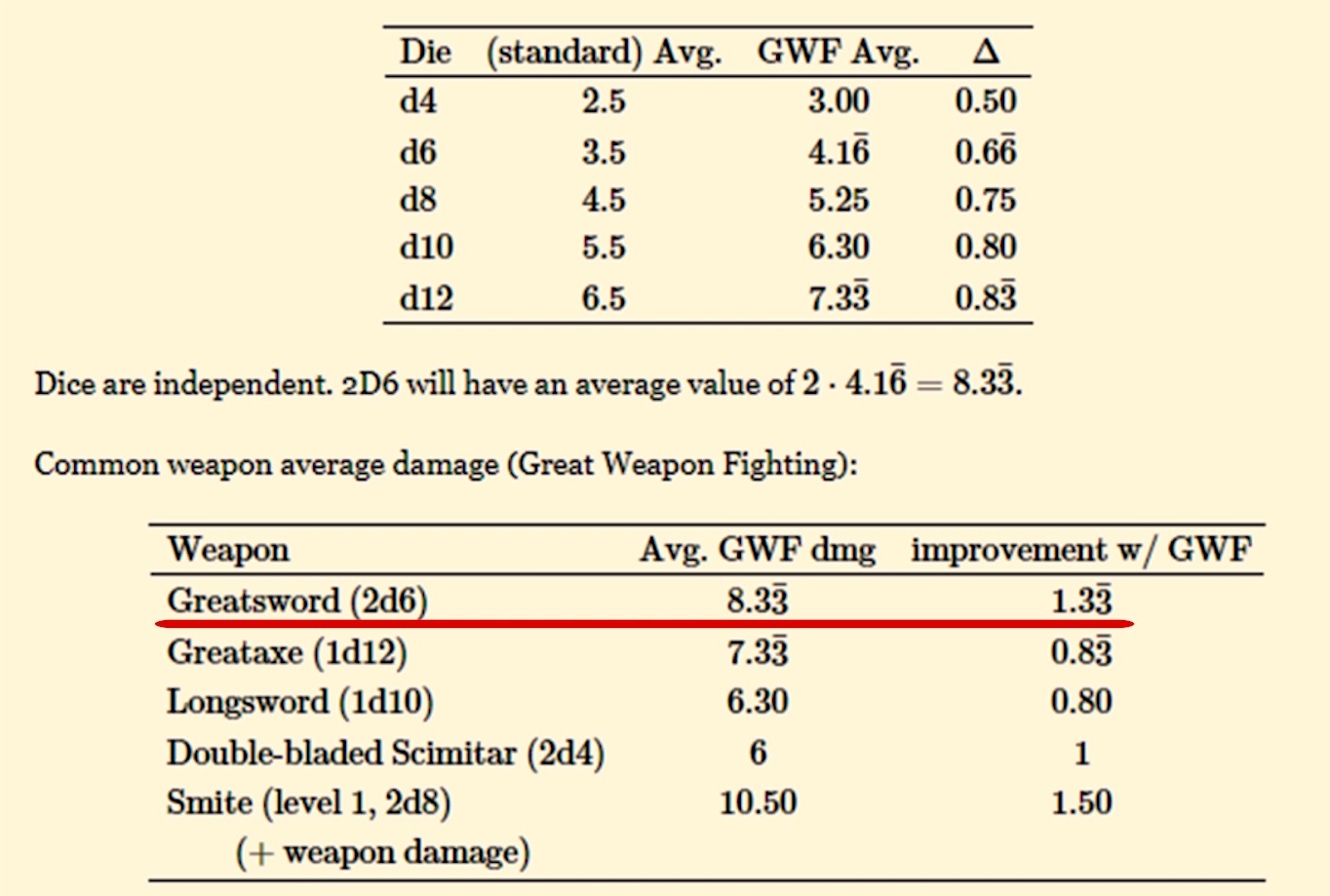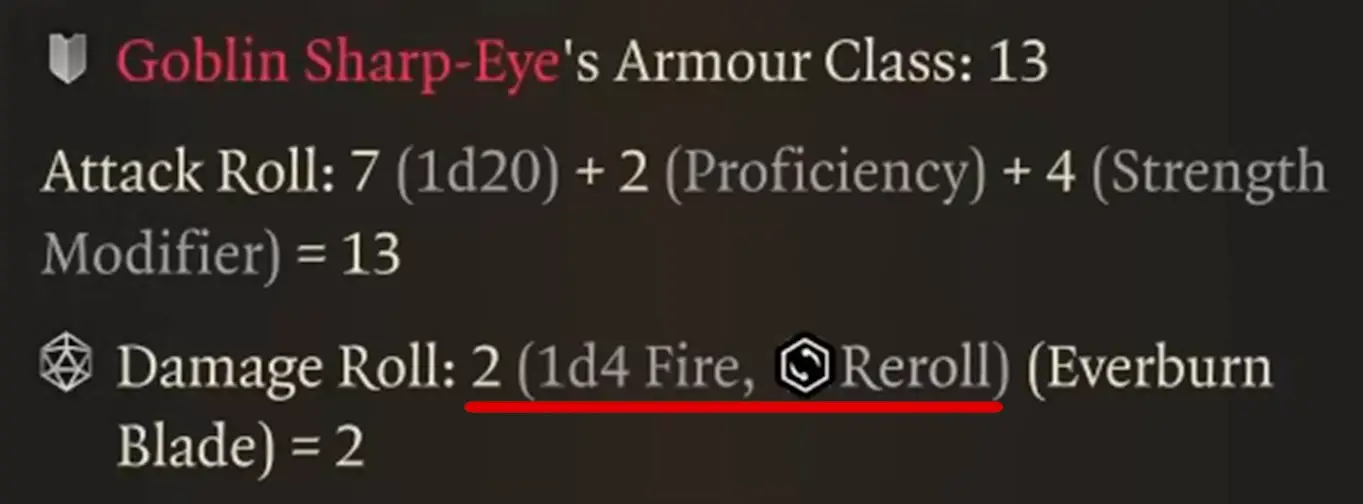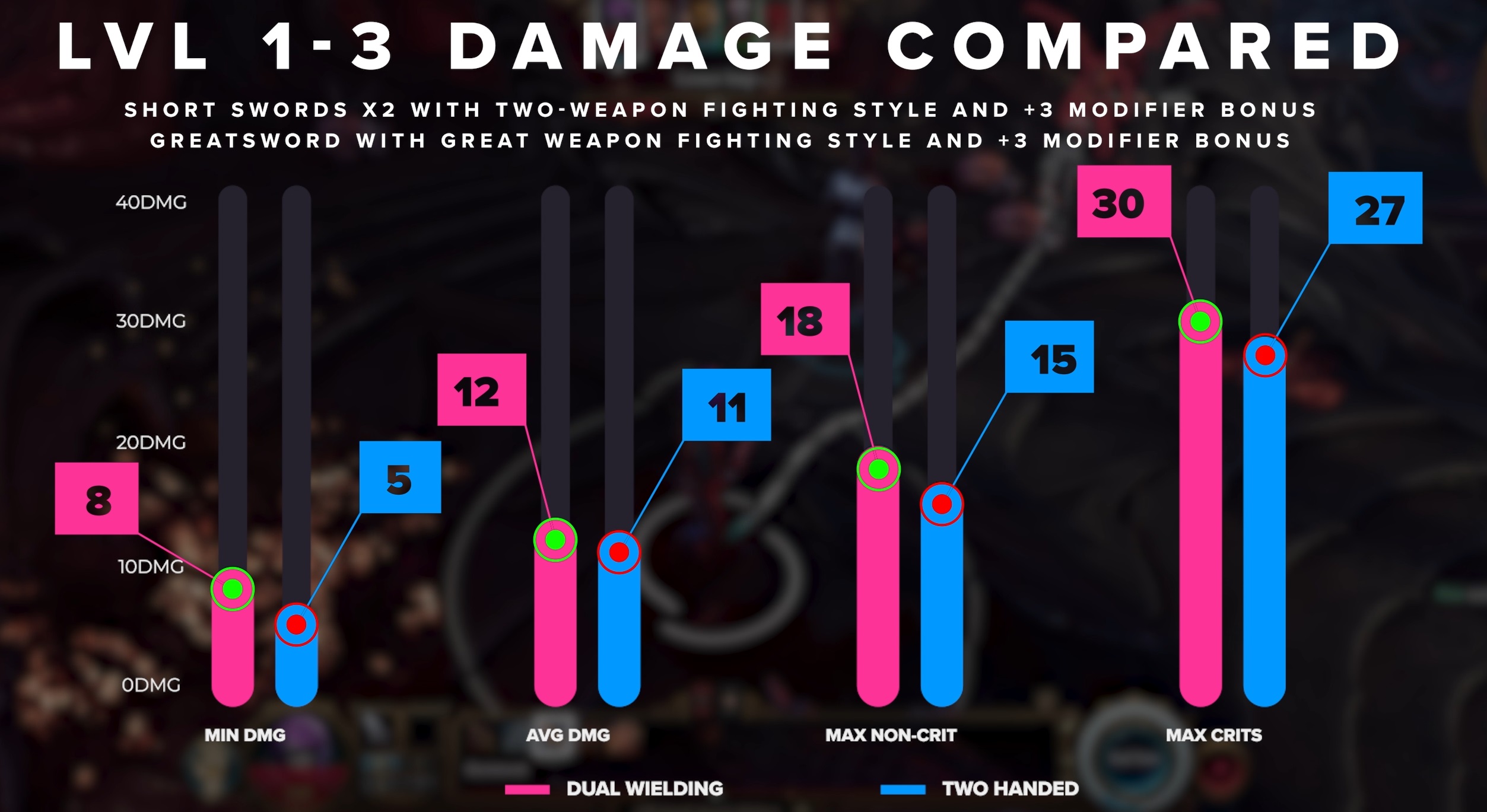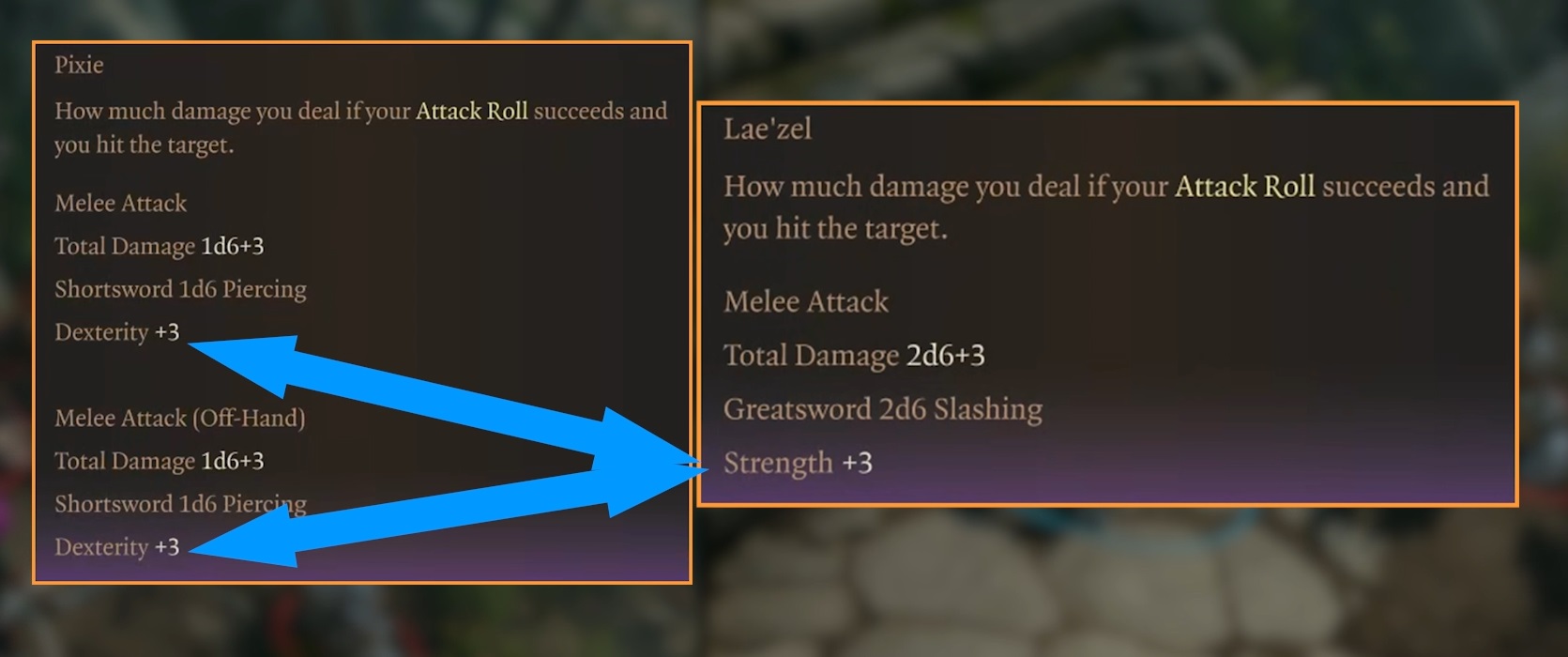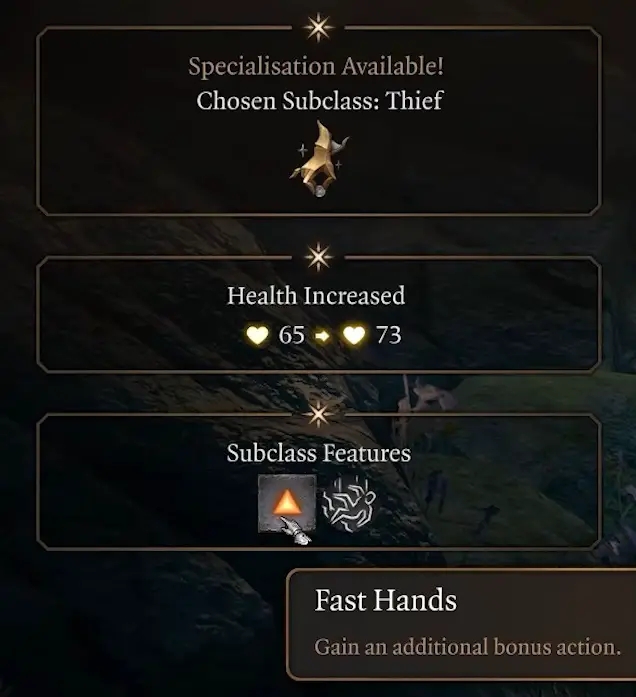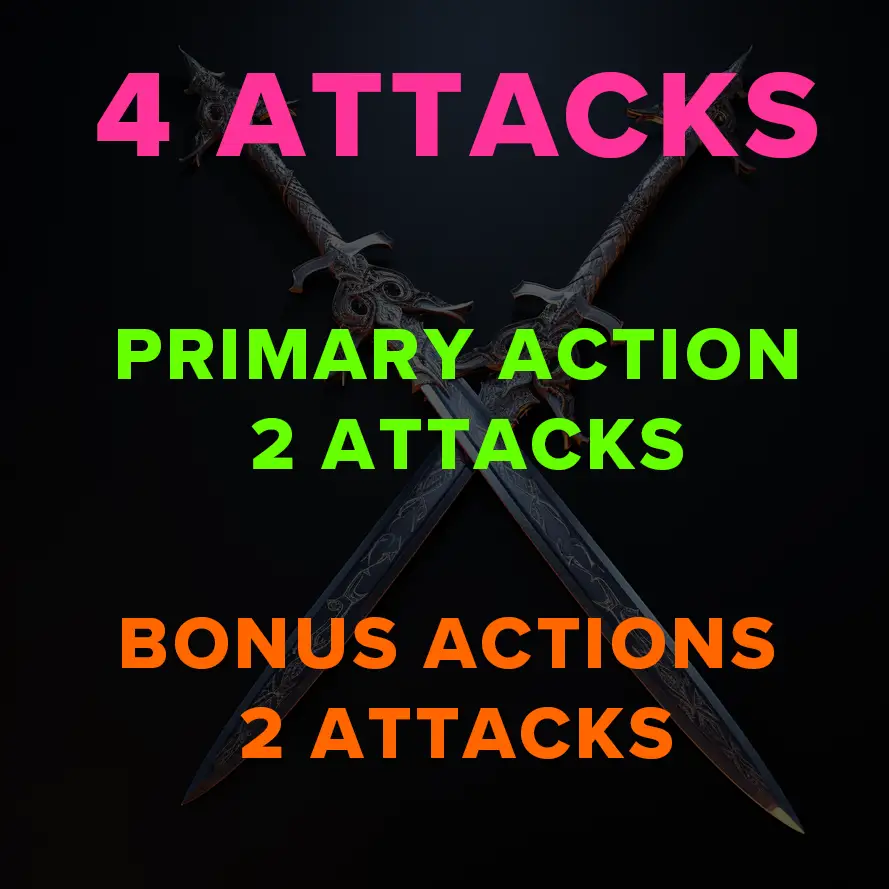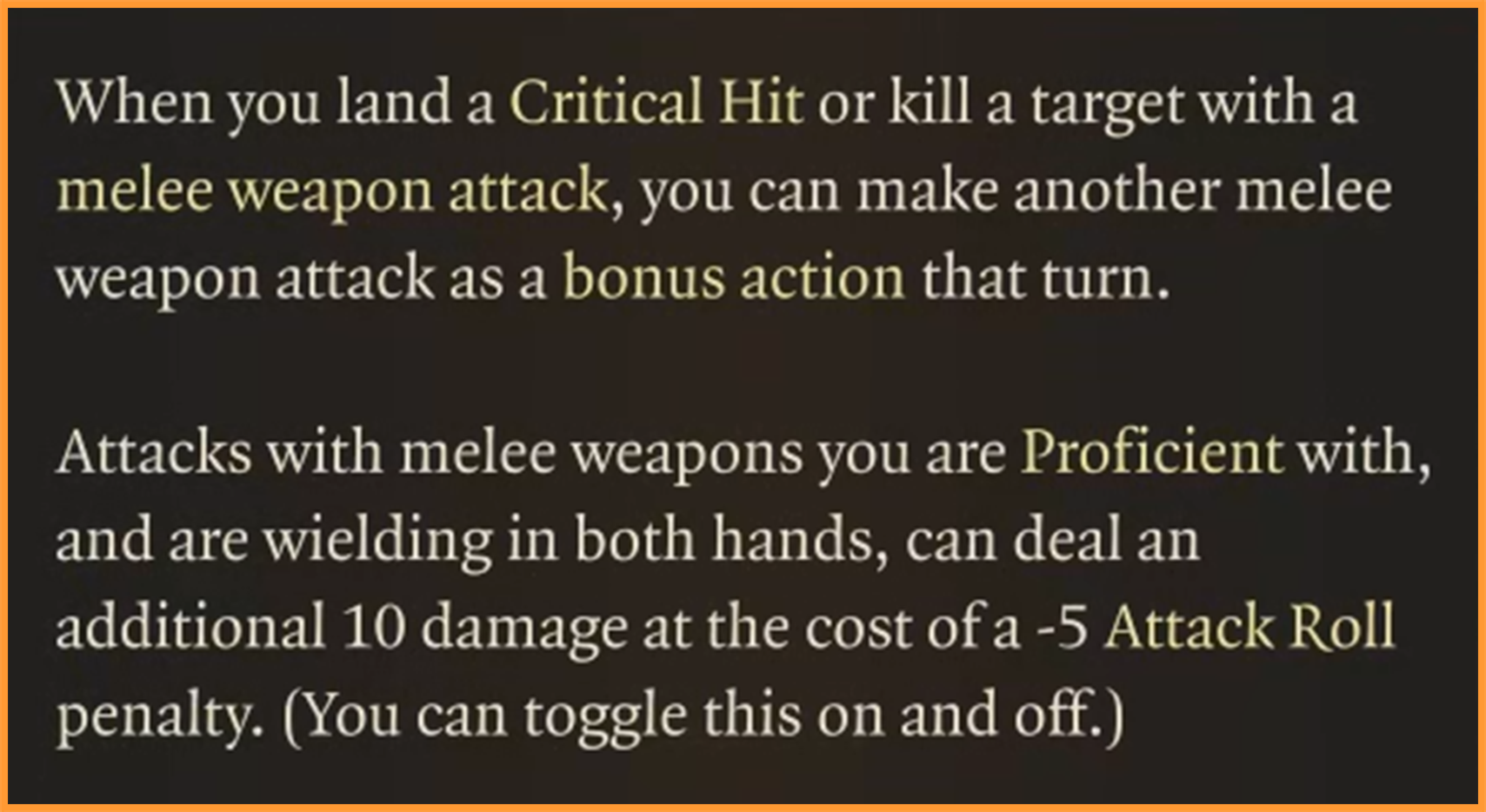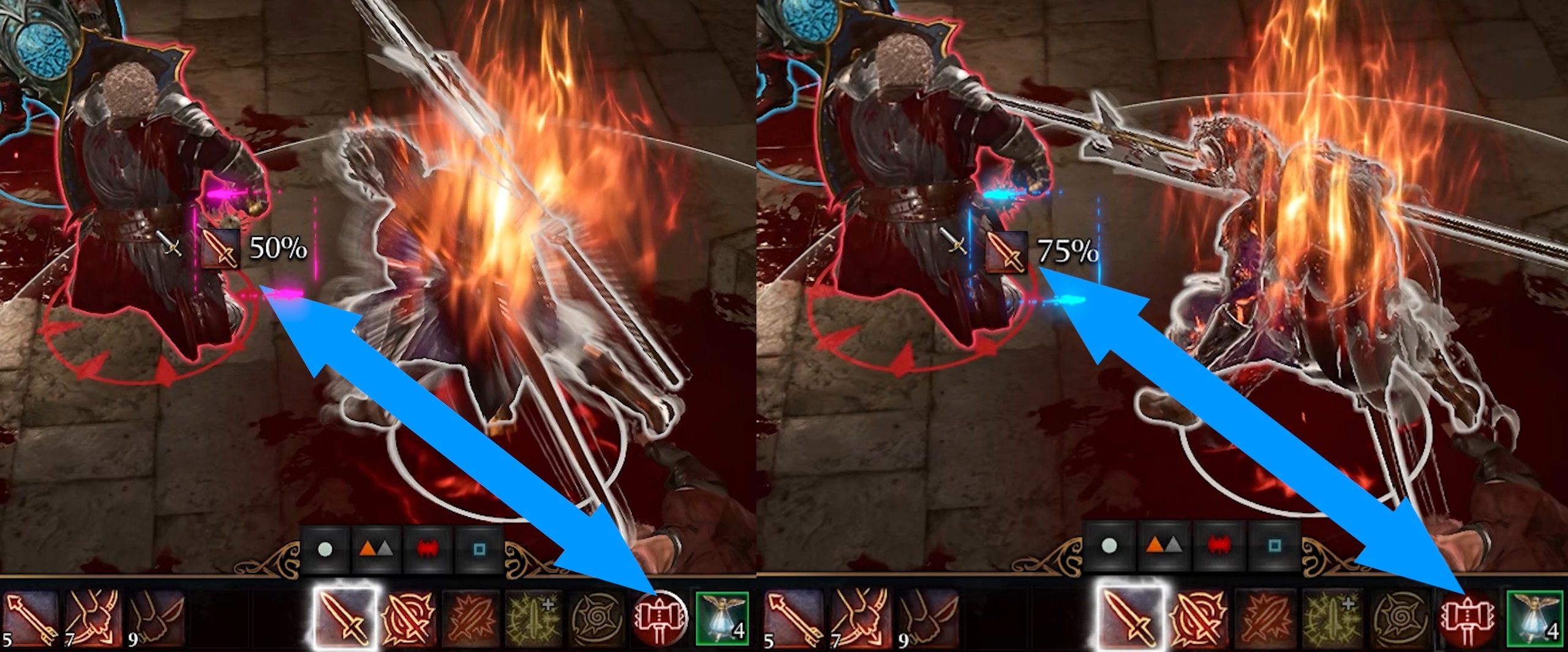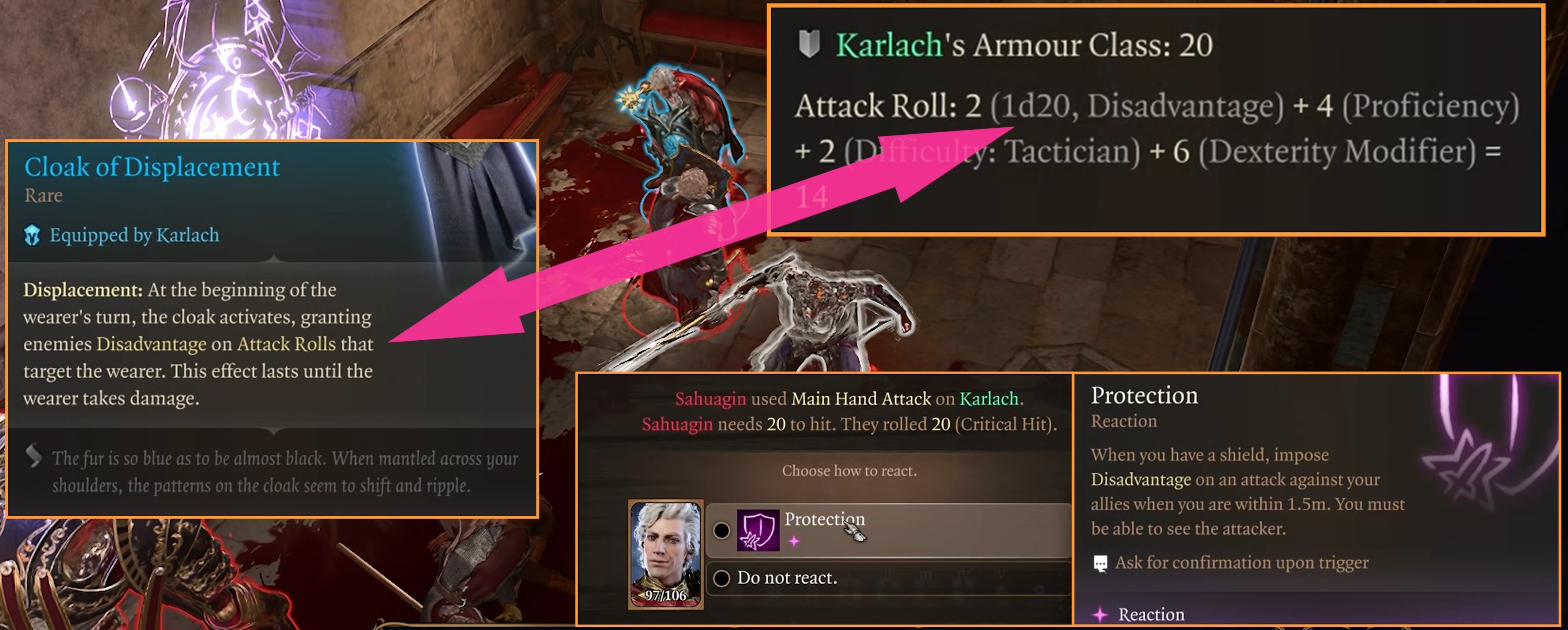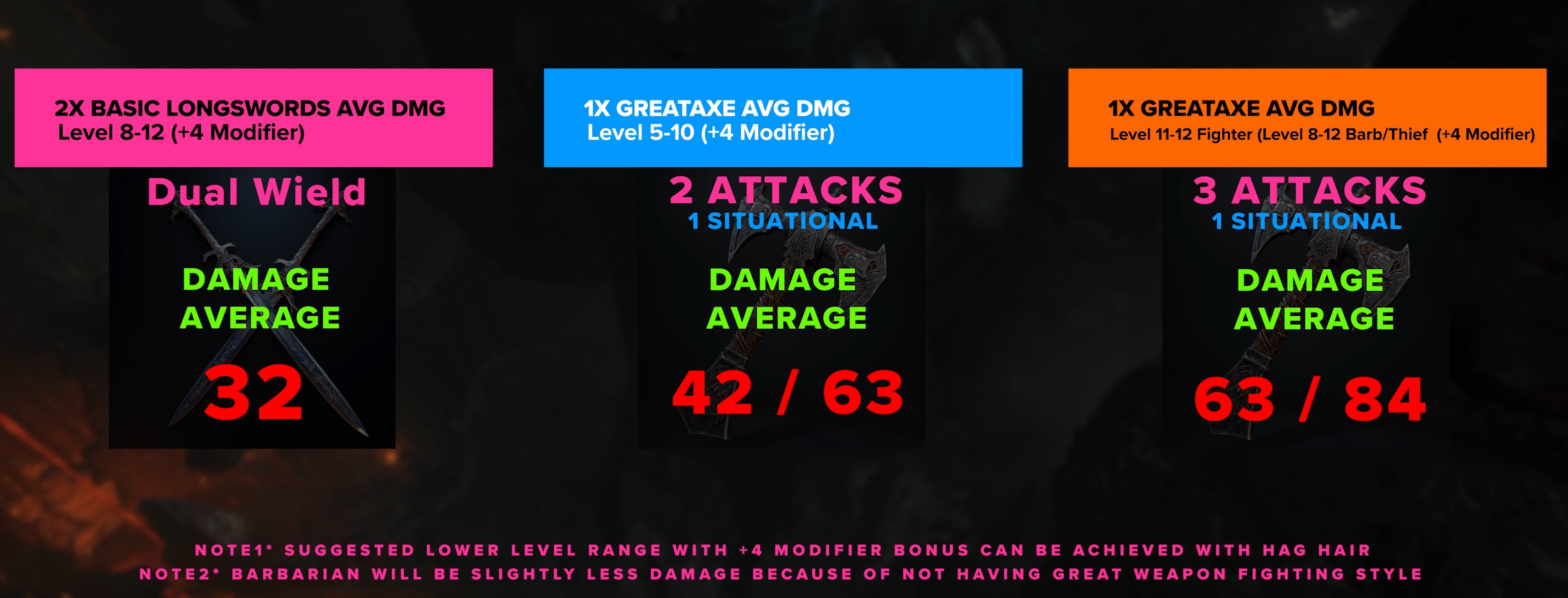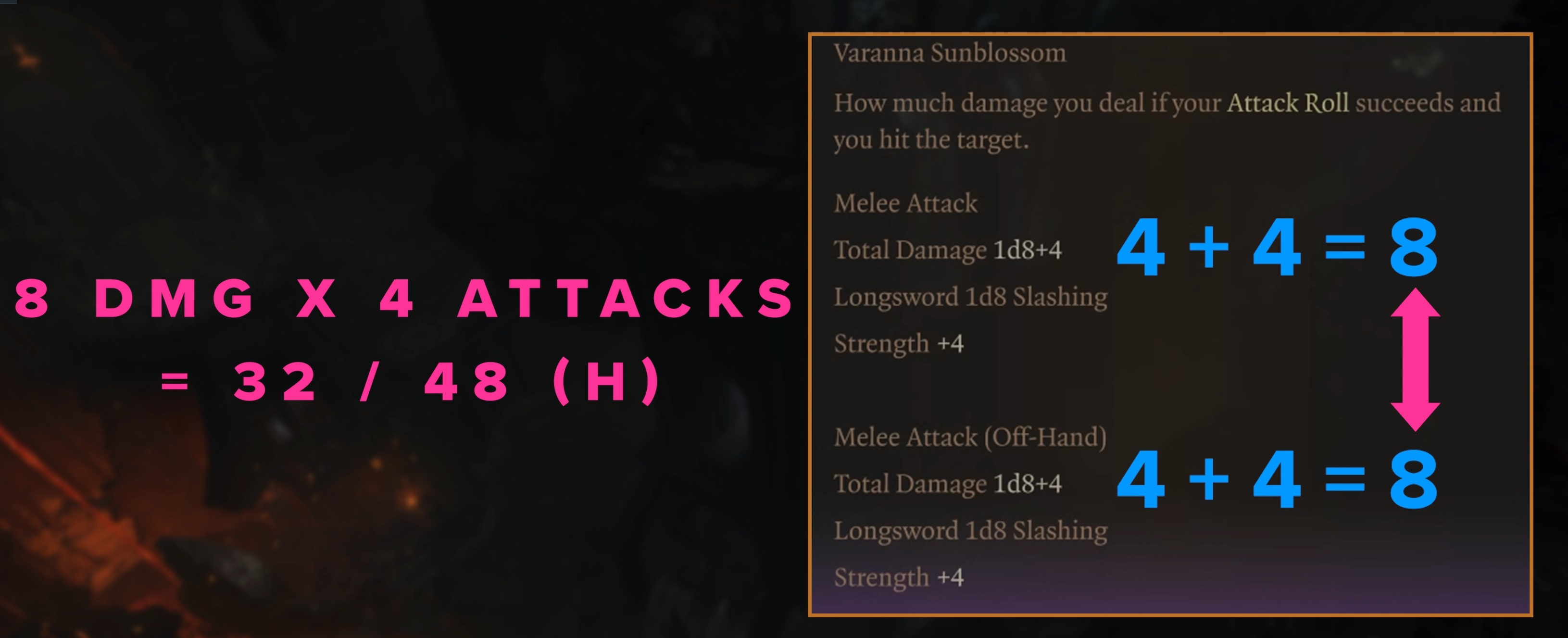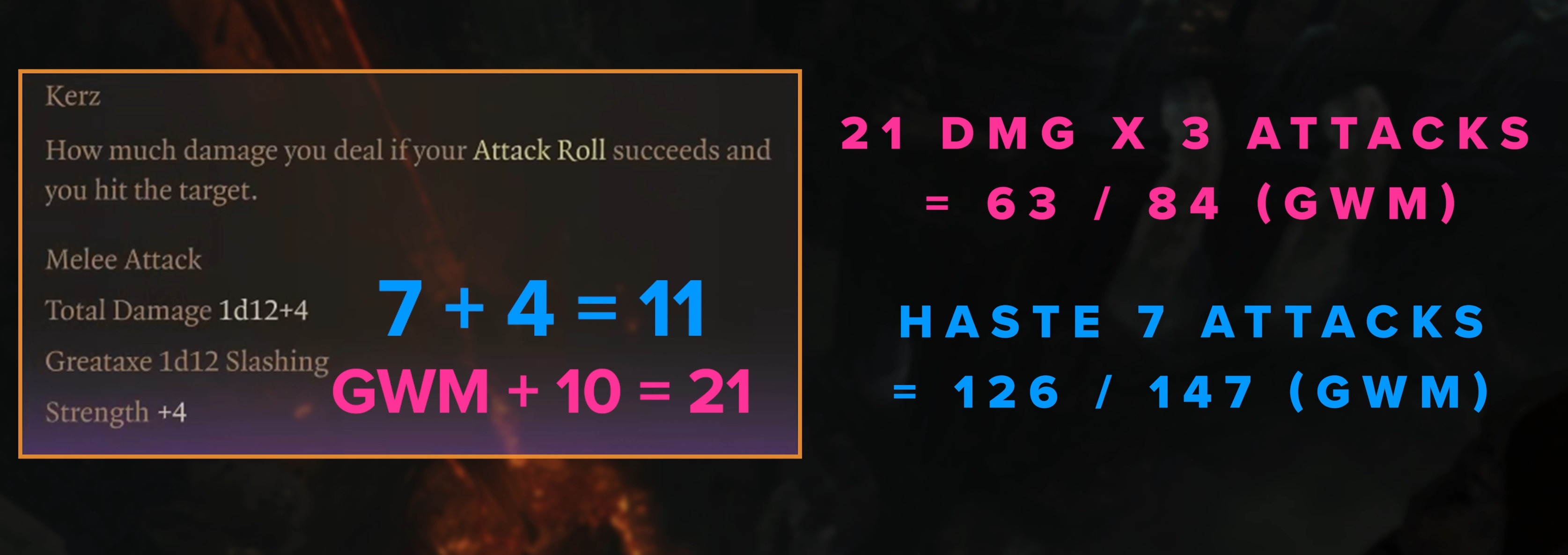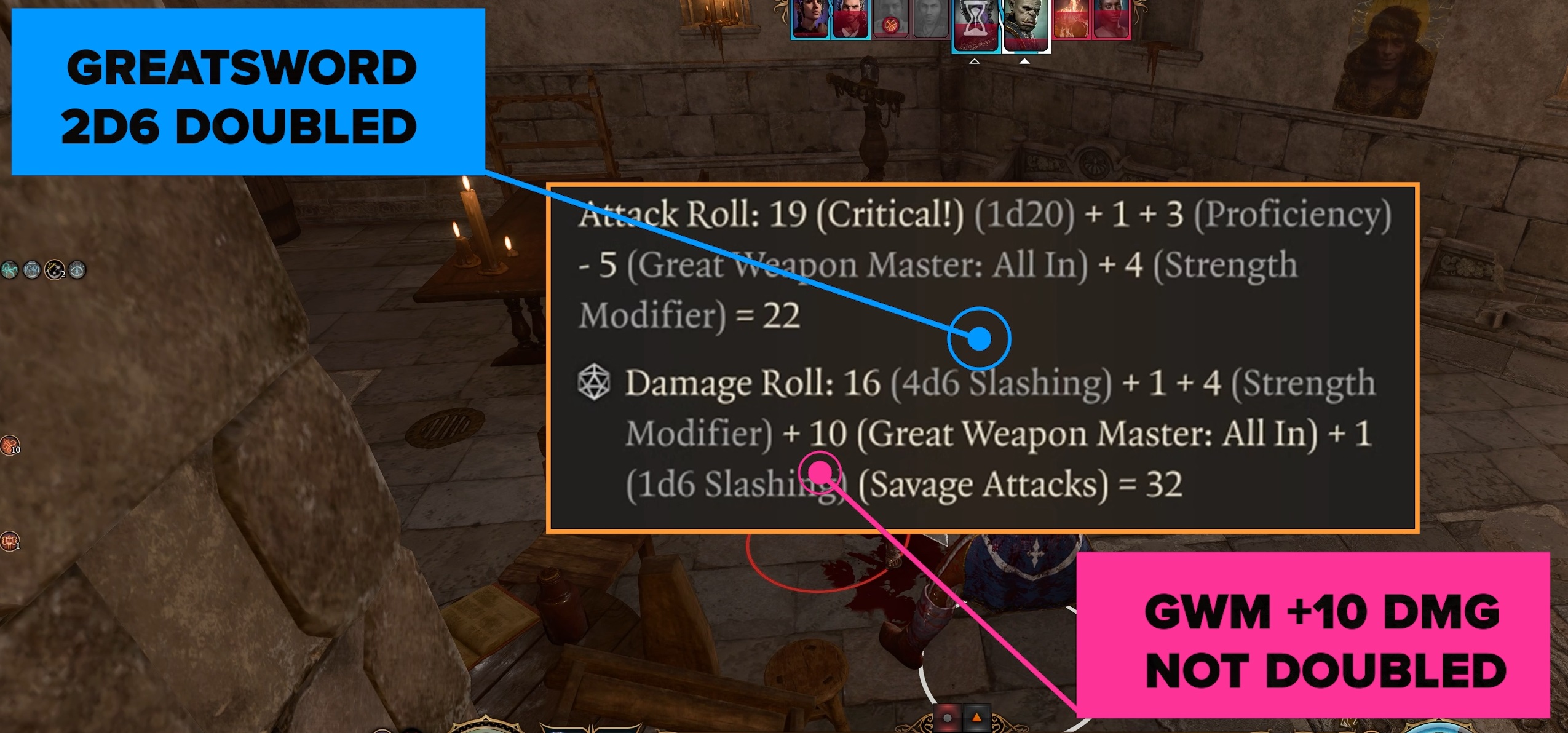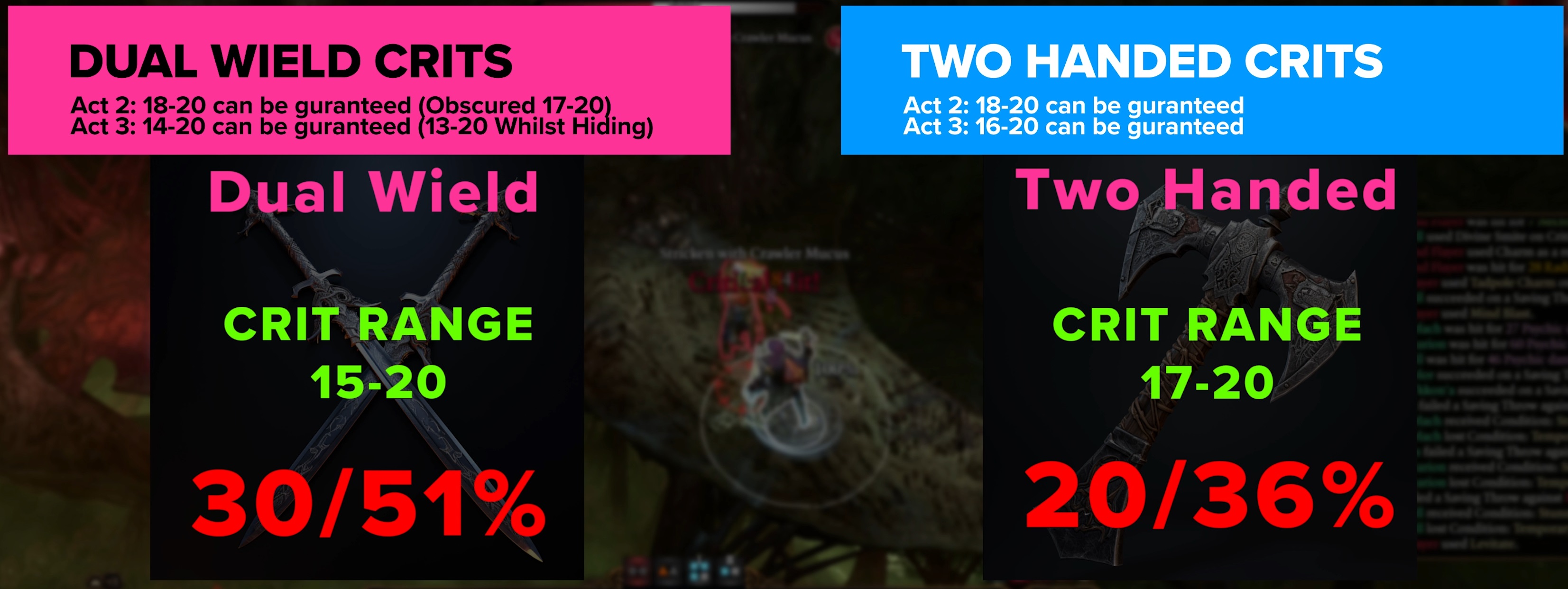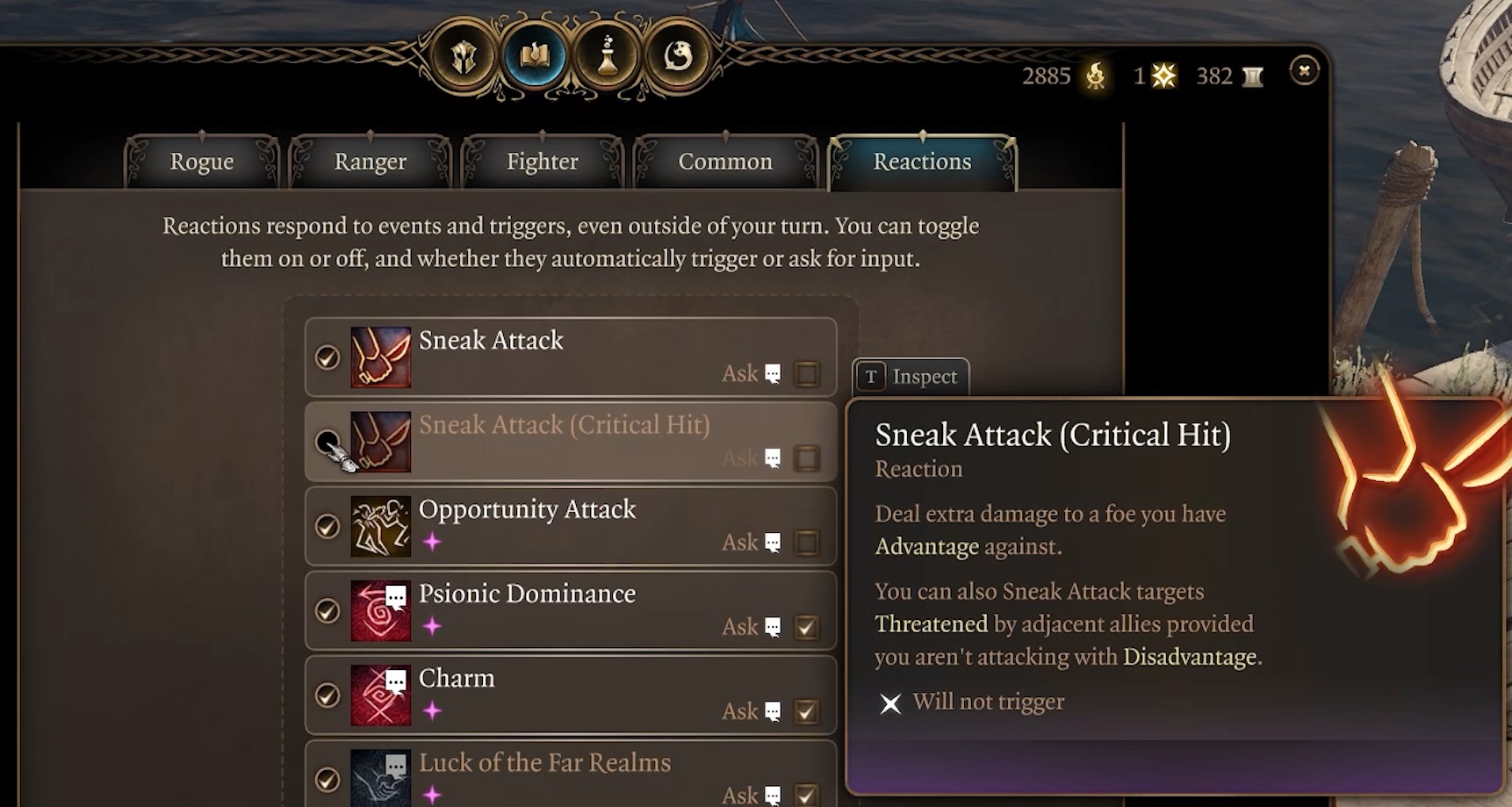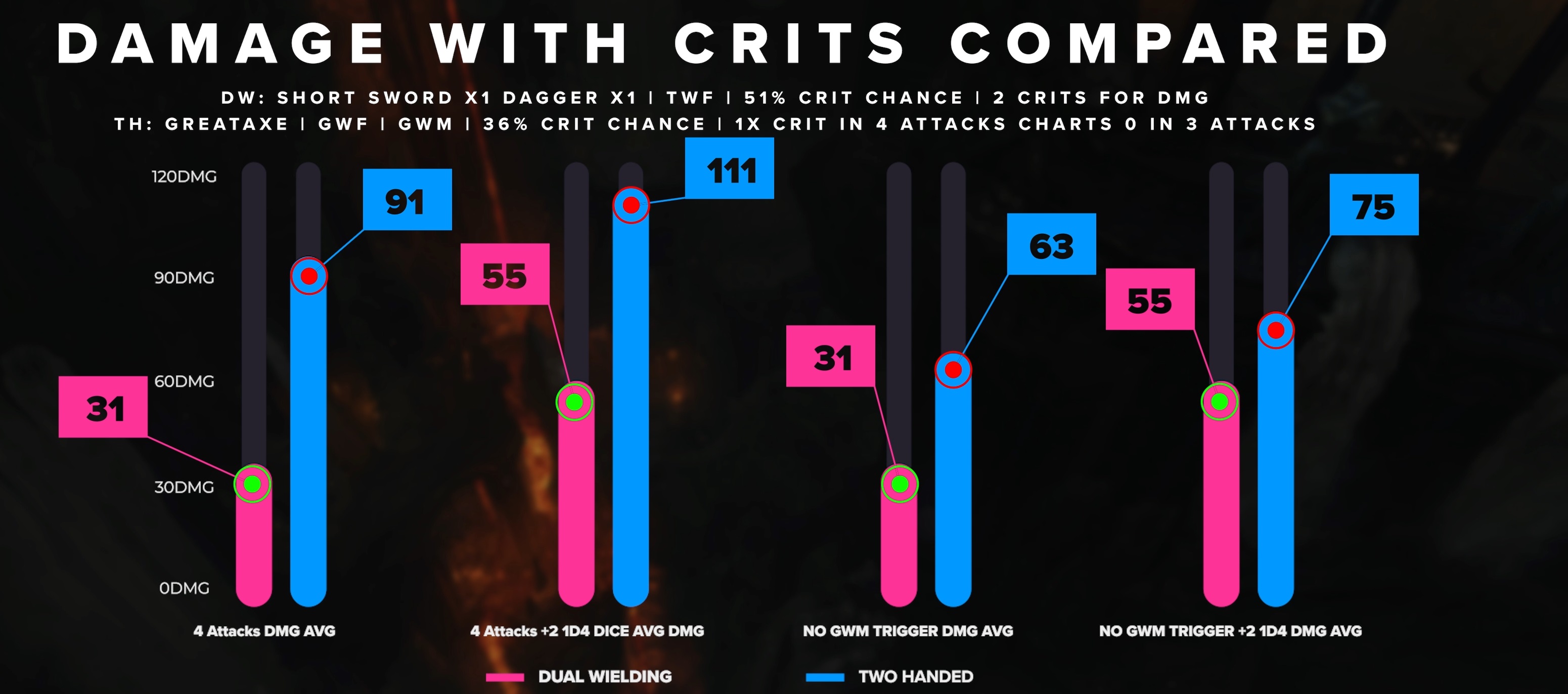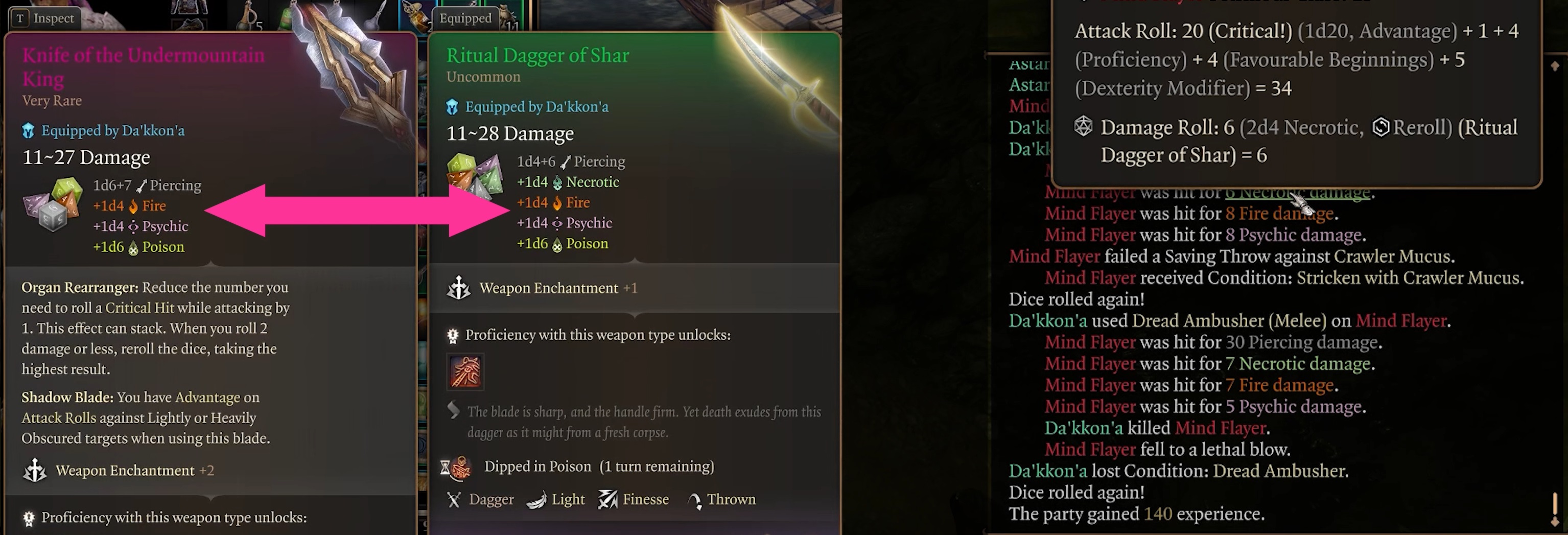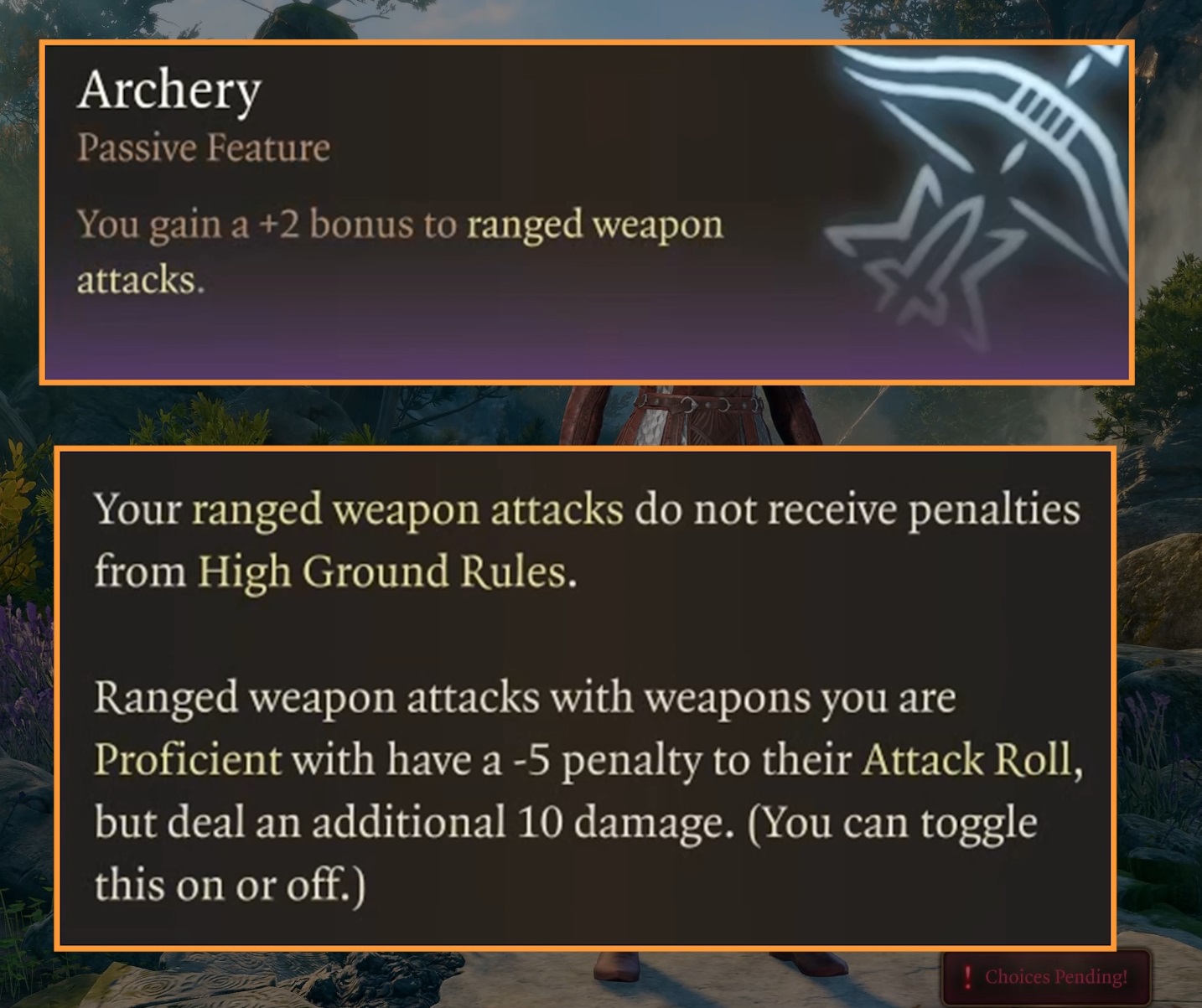I’m writing a guide that compares Two-Weapon Fighting (Dual Wielding) to using Two-Handed weapons in Baldur’s Gate 3. I’ll explain how they function alongside the Fighting Styles and Feats that can enhance them as you progress in levels.
If you’d rather watch than read, there’s a fully animated and voiced video version of this guide available. Alternatively, if you’ve already watched the video, you can use this text version as a quick reference.
Two-Weapon Fighting Basics
When your character is at level 1 without any feats, you can equip two light weapons. You use the shield slot for one of these weapons, treating it as an off-hand weapon. This off-hand attack is separate from your main attack action and requires a Bonus Action.
Your off-hand attack has the same chance to hit as your main hand, except for individual weapon enhancements. However, you don’t add your Ability Modifier bonus to the off-hand attack’s damage. You just roll the weapon’s dice to determine damage.
If you have the “Two-weapon Fighting” Fighting Style, you’ll add your Modifier bonus to the damage of your off-hand attack, making your damage more consistent.
Different classes in the game have access to various fighting styles. Level 1 Fighters, Level 2 Paladins, and Rangers can acquire fighting styles. However, only Fighters, Rangers, and a particular Bard subclass can gain the Two Weapon Fighting style.
If you decide to pursue the Two-Weapon Fighting path, you’ll likely need to dip into one of these classes to obtain it. Additionally, you might need to invest a few more levels for the extra attack granted by these classes at level 5, but we’ll discuss that later.
At lower levels, Two-Weapon Fighting, or Dual Wielding as it’s commonly known, can be quite beneficial for dealing with multiple low-health enemies. It allows you to divide your damage between two attacks, offering flexibility in how you deal damage.
To make this process smoother, I recommend turning off Dual Wielding and manually selecting the target for each of your attacks.
During the early stages of the game, you won’t have many Bonus Action options that are more advantageous than taking an additional attack, regardless of whether you possess the Two-Weapon Fighting Style or not.
Two-Handed Weapons Basics
Using two-handed weapons is simpler to grasp: you roll your damage dice and add your Modifier Bonus to it.
Two-handed weapons generally have more or better damage dice compared to single-handed weapons.
Additionally, there’s the Fighting Style called “Great Weapon Fighting,” which can be acquired by level 1 Fighters and level 2 Paladins.
This style offers a more consistent damage output by allowing you to re-roll any damage dice that land on a 1 or 2.
For example, if you’re wielding a Great Sword that deals 2d6 damage and both dice rolled are 1 or 2, you would re-roll both dice and accept whatever the new roll is.
The advantages of these mechanics are explained thoroughly in a comprehensive post by AceCalhoon.
On average, a Great Sword will deal 1.33 more damage, while a Great Axe will deal an additional 0.83 damage, according to calculations.
This benefit extends beyond the base damage of the weapon because all dice can be re-rolled. For instance, even the additional 1d4 bonus fire damage in an example received a re-roll.
Low Levels Compared
Comparing Dual Wielding and Two-Handed weapons involves some spreadsheet calculations.
For a Fighter at levels 1 to 3 with 17 Strength, wielding a Great Sword and utilizing the Great Weapon Fighting Style, the damage dealt on a hit is 2d6 +3 Modifier Bonus, averaging to 8.33, rounded down to 8, plus 3, resulting in a total of 11 damage to the target.
On the other hand, a level 1-3 Fighter wielding two short swords with 17 Strength or Dexterity, and the Two-Weapon Fighting style, gains two attacks. Each attack deals 1d6 damage, averaging 3.5 (rounded down to 3), plus 3 for the Modifier Bonus, totaling 6 damage for both main hand and off-hand attacks. This amounts to 12 damage potentially spread across two targets, in contrast to 11 damage dealt to one target.
With the two attacks the Character adds their Modifier bonus twice compared to once for Two-Handed Characters. The Great Weapon Fighting Style with re-rolls, closes the damage average gap a bit.
When comparing the two attacks of a dual-wielding character to the single attack of a two-handed weapon character, it’s notable that the dual-wielder adds their Modifier bonus twice compared to once for two-handed characters. Additionally, the Great Weapon Fighting Style, with its re-rolls, helps narrow the damage average gap somewhat.
It’s important to consider that certain classes, like Barbarians, do not have access to the Great Weapon Fighting Style. For example, a Barbarian’s average damage would be 10, trailing 2 behind the dual-wielding character.
Furthermore, the dual-wielding character’s two attacks provide more opportunities to deal damage compared to the single attack of a two-handed weapon character. If the latter misses, they deal no damage, whereas the former still has a chance to deal half their damage.
Moreover, there’s an additional chance for the dual-wielding character to score a critical hit, typically occurring on a roll of 20. While this boost may not be substantial, it’s still advantageous.
At low levels, dual-wielding tends to deal more damage on average, offers more versatility in how damage is outputted, and does so more consistently. However, it’s worth exploring how this dynamic shifts as characters level up.
Dual Wielding at Higher Levels
As your character levels up, Dual Wielding becomes more powerful in a few ways.
Getting the Duel Wielder Feat enables you to wield larger weapons, like two Longswords, which increases your damage output.
The bonus of +1 to Armor Class shouldn’t be overlooked, especially in Honour Mode where survival is key.
But the real improvement comes from gaining extra Bonus Actions, essentially granting more Off-Hand weapon attacks.
The most straightforward method is to take three levels in Rogue with the Thief subclass, providing an extra Bonus Action for an additional attack each round.
At level 8, it’s quite feasible for a character to invest 5 levels into Ranger, focusing on Two-Weapon Fighting and gaining an extra attack at level 5.
Choosing the Feat that enhances your Ability Modifier bonus is a solid choice, although Duel Wielder is an option if you prefer.
Additionally, allocating 3 levels in Rogue with the Thief subclass grants an extra Bonus Action.
Another path is starting with Fighter and later transitioning into Rogue. I suggest opting for Ranger Gloomstalker as you level, especially if you rely on this character for Sleight of Hand checks.
Regardless of the route, this character can execute 2 main hand attacks and 2 Off-Hand attacks each round using Bonus Actions.
This setup guarantees 4 attacks per turn, or 6 attacks when under the effects of Haste.
The Fighter path offers Action Surge, granting a one-off extra two attacks, while the Gloomstalker path with Ranger provides a free extra attack in the first round with bonus damage.
At maximum level, you can re-spec to combine both options and still invest 3 levels in Rogue for the Bonus Action. There are also methods to obtain more than 2 Bonus actions.
However, for simplicity’s sake, let’s focus on the basics for now and disregard the one-off attacks and situational extras.
In this example, the Dual wielding Character can make 4 guaranteed attacks each round. With potentially two Longswords dealing 1d8 damage each and +1 Armor Class for defense.
Two-Handed Weapons at Higher Levels
One of the most remarkable methods of improving Two-Handed Weapons is through the Great Weapon Master Feat.
It offers a trade-off: you take a -5 penalty to hit, which can be challenging, but in return, you gain an impressive additional 10 damage when your hits connect!
You have the flexibility to toggle this feature on and off, allowing you to decide when it’s worthwhile depending on the target.
The -5 penalty to hit does increase the risk of dealing zero damage. However, this risk can be mitigated by abilities like Reckless Attack for Barbarians, granting Advantage on the attack roll, or by utilizing items like the Risky Ring.
Reckless Attack does have implications for the character’s defensive capabilities, as it grants Advantage to the enemy’s attacks, which can be particularly perilous in Honour Mode. However, even this risk can be somewhat alleviated with items or other character abilities.
In addition to its primary effects, Great Weapon Master can also provide an extra attack via a Bonus Action upon scoring a Critical hit or kill. While situational, this feature offers a significant chance of activation, thereby increasing our damage potential with an additional attack.
Damage Breakdowns at High Level
To figure out the damage potentials, let’s first look at the number of attacks each character will have.
For the Dual Wielding Character, they’ll have a solid 4 attacks per round. That’s 2 from their primary attack and an additional 2 from Off-Hand Bonus Actions.
Now, for Two-Handed weapon Characters, it’s a bit different. They’ll reliably get 2 attacks with their Primary Action attacks. Then, there’s a chance for a third attack as a bonus action, but only if Great Weapon Fighting kicks in.
Moving on to level 11 Fighters with Improved Extra Attack, they’re stepping it up with three guaranteed attacks, possibly even 4 if the stars align.
As for Barbarians, they’re not to be underestimated. By round 2, they can match the Fighter’s output. With Frenzy strike and potentially gaining a second Bonus Action, like by dabbling in Thief, they can reach up to 4 attacks per round. And let’s not forget the potential boost from Great Weapon Fighting.
Let’s break down the damage calculations for the Dual Wielding character using basic weapons and a +4 Modifier bonus.
With two Longswords, each dealing an average of 4 damage (rounded down from 4.5), and adding the +4 Modifier bonus, each attack will result in 8 damage.
Since both the main hand and off-hand attacks are the same, we’ll multiply this by 4 for the total number of attacks, resulting in 32 damage without Haste.
With Haste, which grants an additional action, the total damage jumps to 48.
Let’s delve into the damage calculations for Two-Handed weapon characters, specifically those wielding a Greataxe with Great Weapon Fighting.
The average damage of a Greataxe, considering Great Weapon Fighting, is 7 (rounded down from 7.33). Adding the +4 Modifier brings it to 11. Additionally, the Great Weapon Master feat provides a hefty +10 damage, bringing the total to 21 damage per hit.
With three attacks, this totals to 63 damage, or potentially 84 if Great Weapon Fighting triggers for an additional attack. With the addition of Haste, the damage potential rises to 126, or even 147 if Greater Weapon Fighting triggers.
On the surface, Two-Handed weapons indeed seem to outshine Dual Wielding in terms of damage output. However, there’s more to consider.
Consistency and Defense
When you’re dual-wielding, things are more consistent. Your damage isn’t as high, but it stays steady. You can usually pull off those 4 attacks each time, unless you have to do something like jump or take a sip of a potion.
Hits are more likely to land since you don’t suffer from that -5 penalty, meaning you’re dealing damage more reliably. Plus, you get a little boost with +1 Armor Class, which can really come in handy, especially if the big, two-handed character is relying on risky moves like Reckless Attack to make up for the lower chance to hit.
Having that extra Armor Class is a big deal compared to giving your enemies Advantage, which makes it easier for them to hit you.
Now, for the two-handed weapon folks, they trade those perks for the potential to deal a ton of damage in one swing. They can take enemies out of the fight faster, which means less damage coming your way because those enemies have fewer chances to attack.
But there’s a neat bonus for dual wielders: you get more bonuses and special abilities with those two weapons you’ve got. It’s like getting double the perks, which can really shape how you build your character.
Critical Hit
Critical hits in a game double the dice rolled for damage, not the total damage, meaning modifiers and flat damage boosts like Greater Weapon Fighting’s +10 don’t get doubled.
However, all dice involved in the attack, including any additional bonus dice, get rolled twice. This detail is crucial because Dual Wielding characters have ways to enhance their Critical hit potential compared to their Two-Handed counterparts.
One standout option is the Knife of the Undermountain available in Act 1, and Bloodthirst obtained later in Act 3. These items can push Dual Wielding characters’ Critical hit range 2 steps ahead of Two-Handed characters.
By Act 3, achieving a Critical hit range of 15-20, or even lower with situational bonuses, isn’t too difficult for Dual Wielding characters, compared to the 17-20 range for Two-Handed weapon wielders.
With a Critical range starting at 15, there’s a 30% chance of landing a Critical hit per attack. If you have advantage, that chance jumps to 51%.
In contrast, Two-Handed Weapon characters have a 20% chance per attack, or 36% with Advantage, to score a Critical hit.
A Critical hit can transform a basic 1d4 dagger attack, with an extra 1d4 bonus damage dice, into a hefty 4d4. Add a Half-Orc’s Savage Attack feature, and now it’s 5d4. And the potential for even more damage arises when you stack additional damage dice onto the attack, all of which also get doubled.
This significantly boosts the damage output, bringing dual wielding closer to the damage potential of a Two-Handed Weapon character, despite the latter having a lower Critical hit chance.
Both Sneak Attack and the Gloomstalker’s Dread Ambusher attack benefit from doubled damage dice on a Critical Hit, providing another significant damage boost when triggered. Even though these attacks may be situational, they’re worth considering for the extra damage potential.
You can further increase your chances by setting up Sneak Attack to automatically trigger on Critical Hits. This allows you to attack as usual, and if you land a Critical hit, Sneak Attack will be applied automatically. Just remember to keep a Primary Attack as your final action, so you still have the option to manually apply Sneak Attack if you don’t land any Critical hits.
Breaking down the numbers again, it’s clear that Two-Handed Weapon damage still outpaces Dual Wielding by a significant margin.
Assuming both characters have advantage on all attacks, here’s the breakdown:
- The Dual Wielding Character, with a 51% Critical Hit chance, will land 2 critical hits out of 4 attacks.
- The Two-Handed Weapon Character, with a 36% Crit chance, will get 1 critical hit. We’re considering the best-case scenario where a Critical hit is achieved in the first 3 attacks, triggering Greater Weapon Fighting for the situational 4th attack.
Even with advantage factored in, the average damage heavily favors Two-Handed Weapons. Even if no Critical hits are rolled, the average damage across 3 attacks still surpasses that of 4 attacks when Dual Wielding.
This chart doesn’t include Sneak Attacks or other additional one-off damage the Dual Wielding Character might have access to. An extra 2d6, potentially 4d6 with a Critical hit from a sneak attack, brings you closer to the damage output of a Two-Handed character.
Moreover, stacking additional damage dice on attacks favors the character with a higher chance to roll Critical hits, further narrowing the gap.
However, on average, Dual Wielding Characters will still deal less damage compared to Two-Handed characters. The Great Weapon Master Feat, providing a +10 damage bonus, is particularly impactful and doesn’t rely on specific items or needing Critical hits to achieve it.
That said, it’s not to say you should never Dual Wield. In my current Honour mode run, for instance, I have a Gloomstalker, Rogue, Fighter using two light weapons going full Crit.
Where this information becomes crucial is in deciding how many Dual Wielding Characters to include. It takes a significant investment in items to lower your Critical Hit range and stack bonus damage dice just to approach the damage output of Two-Handed Characters. Therefore, it may not be worth it to have multiple Dual Wielding Characters.
However, what if there’s a way to Dual Wield and still get the +10 damage per hit?
Hand Crossbows
Hand Crossbows indeed provide a solution to this dilemma!
By selecting Archery as the Fighting Style, you gain a flat +2 bonus to hit with ranged weapons. Pair this with the Sharpshooter Feat, which offers the option for -5 to hit in exchange for +10 damage, akin to Greater Weapon Master.
With this setup, your character can still maintain the 4 guaranteed attacks using Off-hand bonus actions while dealing an impressive amount of damage at range, with an additional +10 damage on each hit.
Moreover, the Crossbow Expert Feat allows you to perform all of this even at close range.
While the Hand Crossbows currently available might not be top-tier, the potential for dealing significant damage at range remains undeniable!
That's everything we are sharing today for this Baldur's Gate 3 guide. This guide was originally created and written by Gaming Existence. In case we fail to update this guide, you can find the latest update by following this link.
